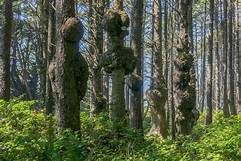Written by Steve Nix and published on https://www.thoughtco.com/.
Burls are hard, woody protuberances that grow on the roots, trunk or branches of nearly every tree species. Their growth is chaotic, and they feature irregular grain patterns that do not match the grain of the rest of the tree. Burls continue to grow as the tree grows. They can span from several inches to several feet across. They do not harm the tree directly, but there is some scientific evidence that burls make a tree more susceptible to insects and disease. Burls are prized among woodworkers due to their unusual swirling grain pattern, and burl wood is often used in the making of musical instruments. Burls can be identified by sight and touch.
Table of Contents
Recognizing and Controlling a Tree Burl
Finding, Identifying, and Selling Tree Burls
:max_bytes(150000):strip_icc():format(webp)/Burl_Forest-5c4f658546e0fb0001f220dd.jpg)
Little research has been done to confirm the cause (or causes) of burls. A burl could be caused by many environmental factors, but the biology of burls on trees is not well known. To be sure, burls and galls may serve as secondary infection avenues for insects and diseases, but as a rule, they do not appear to be harmful to most trees and maintain protective bark.
Burl-Like Symptoms
The tree trunk infections called “burls” look like bumps or warty growths, probably caused as a result of an environmental injury. Cambial growth is hyper-stimulated as a way for the tree to isolate and contain the injury. Almost all burl wood is covered by bark, even when underground.
Often, a tree that has developed burl wood is still generally healthy. In fact, many trees with burl wood will go on to live for many years. Still, burl wood in vulnerable spots or with off-shooting growth can become so large and heavy that they create additional stress on a tree, and can cause the tree to break apart.
Oak Tree Burl Bulges and Tree Health
Even though not much is known about the cause of burls, it should be assumed that proper tree management that improves tree health can help reduce the occurrence of burls or make their presence less of a problem. Burls certainly should not be removed from the main stem of a living tree, since that would expose a large decay-producing wound or completely kill the tree. Burls can be removed if they are located on branches or limbs and proper pruning methods are used.
Not All Burls Are Bad
Burls can yield a peculiar wood that is prized for its beauty and sought-after by furniture makers, artists, and wood sculptors. There are a number of well-known types of burls. Quality burl wood often comes from redwood, walnut, buckeye, maple, baldcypress, teak, and other species. The famous birdseye maple superficially resembles the wood of a burl but is something else entirely.
Burls Are a Valuable Wood Product
Some tree burls can be valuable in the specialty wood market. Cherry and ash trees are popular burl-producing species due to their remarkable grain. Oak trees, on the other hand, tend to mill out with defective rot and holes and are usually rejected by wood buyers. Depending on quality and size, walnut, redwood, and maples often yield quality burls, but most tree species can offer rare gems.
If you have a large burl on a tree you might want to sell, measure its size and take photos from several angles. It would help to include a yardstick in the photo for perspective. The burl must be covered with sound bark and have no major rot. Its value is significantly higher with increased size.
The best market for burls is among woodturners. Search for woodturners locally using the internet and the American Association of Woodturners.
Original post here https://www.thoughtco.com/what-is-a-tree-burl-1342918/.

